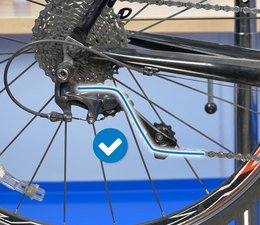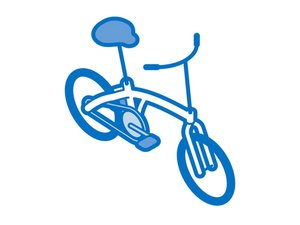Causes
Chain length is important to ensure your bicycle shifts correctly. An excessively long (loose) bike chain can lead to dropped chains and inconsistent shifting, both in the front and back. On the other hand, a chain that is too short (tight) can result in potential serious issues, such as difficulty shifting into the largest cog or big ring. In extreme cases, it may lead to damage to the derailleur, chain, or gear teeth. Striking the right balance in chain length is crucial, as being too long can be bothersome, while being too short can lead to expensive repairs or damages. To check your bike's chain length, shift to the big chainring and the largest cassette cog. Push the end of the derailleur cage forward; if it moves slightly, the chain length is good. If it moves significantly, the chain is too long. If it feels tight, there might not be enough chain. This simple test helps assess whether the chain length is appropriately adjusted for optimal bike performance.


Chain wear occurs primarily at the pin and roller interfaces. As the chain experiences tension and flexion during cycling, the metal surfaces wear down, leading to an increase in the chain's effective length. This elongation can result in a phenomenon known as chain stretch, even though the metal itself isn't physically stretching. If a chain is allowed to wear excessively without replacement, it can accelerate the wear on other drivetrain components, such as the cassette and chainrings.
There are a few ways to check for bicycle chain wear: Using a specific chain checking tool, or a ruler.
Chain Tool:

Ruler:
Using a ruler, a standard measurement involves exactly 12 inches across 12 links, from the middle of one pin to the middle of another. The generally accepted threshold for chain wear is a one percent elongation between links. However, it's recommended to replace the chain before reaching this point to prevent unnecessary strain on other drivetrain components. Once the chain measures past 12 1/16 inches (0.5 percent elongation), it's advised to replace it. If it surpasses 12 1/8 inches (one percent elongation), the chain has experienced considerable wear, and replacing the cassette may also be necessary for maintaining optimal cycling performance.


To assess the condition of your bicycle's drivetrain components, focus on three key areas. For the cassette, inspect the rear wheel's cluster of gears for signs of wear, such as hooked or shark fin-like teeth. Run your fingers along the teeth to detect any irregularities. Similarly, check the front gears, or chainrings, for wear, which might be indicated by hooked or asymmetrical teeth and noticeable wear patterns. Additionally, examine the rear derailleur's jockey wheels (pulleys) for worn or damaged teeth, as these can impact shifting performance. Regular cleaning and lubrication of the derailleur pulleys are recommended for optimal functionality.
Each derailleur should have two screws, corresponding to the high and low limits. These control the range of motion of the derailleur and, if improperly adjusted, can send your chain flying off either side of the cassette or chainring. If you most commonly lose your chain when shifting into your highest or lowest gears, and the chain always comes off either the cassette or chainring first, you can narrow your issue to the limit screws on the front or rear derailleur.
You're seeing solutions for Bicycle. Select your model to find parts for your device.







